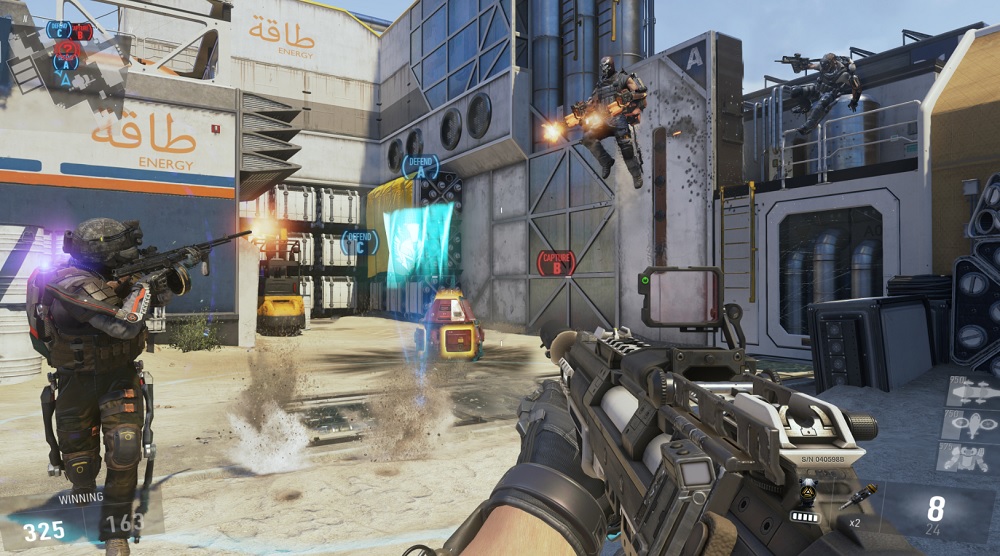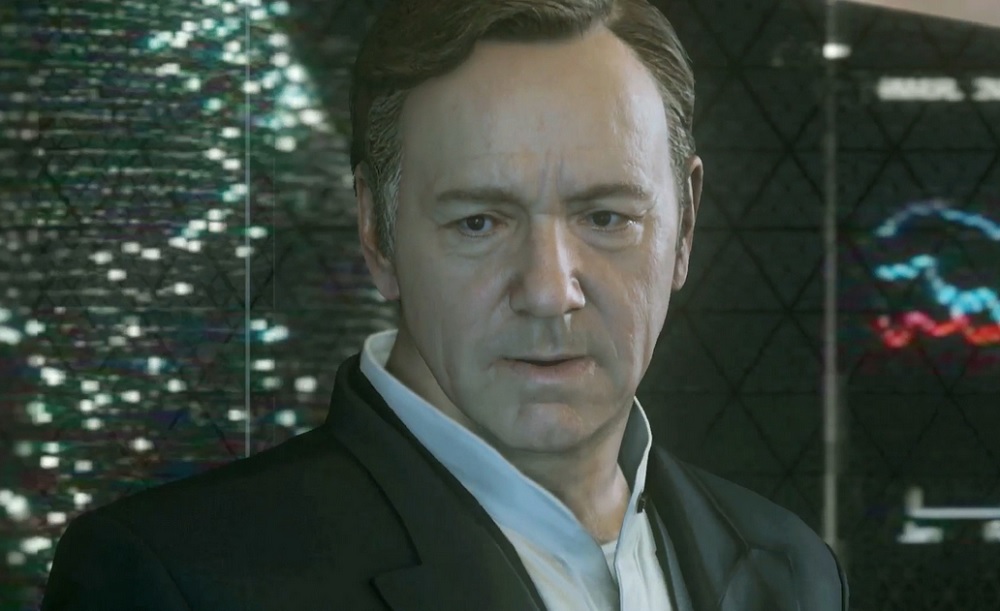This review has some limited story spoilers and focuses on the single-player aspect of Call of Duty: Advanced warfare. GamesBeat will run a later review of the multiplayer after release. –Ed.
Check out our Reviews Vault for past game reviews.
Lots of people are trying to predict the downfall of Call of Duty, particularly analysts who are worried about Activision Blizzard’s stock price. Someday, they figure, the 40 million who play the games every month are going to get tired of it. Battle fatigue and gravity have to kick in.
But the naysayers tend to forget one thing. Call of Duty is fun and engaging, and that’s why they sell more than a billion dollars’ worth of games every year: That’s still the case with Call of Duty: Advanced Warfare, the 11th major installment in the first-person military combat game series coming to the PlayStation 4, Xbox One (reviewed here), PlayStation 3, Xbox 360, and PC. The series has generated more than $10 billion in revenue and sold more than 175 million games, making it perhaps the highest-selling hardcore game series next to Grand Theft Auto. Disappointment in this context is a relative term: If it sells less than 20 million copies, Advanced Warfare will be a disappointment. But having played it, I still like it. And I think this year’s Advanced Warfare is better than last year’s Call of Duty: Ghosts. Last year’s Call of Duty was supposed to usher in the next-generation of gaming, but this one from Sledgehammer Games really feels like the real thing.
Call of Duty: Advanced Warfare takes the modern combat series far enough into the future — the years 2051 to 2061 — to be considered science fiction. By coming up with a dramatic story set in the future and weapons that take high-tech lethality to a new level, Sledgehammer Games is making an impressive entry as a developer of Call of Duty games. The franchise is now rotating each year among Sledgehammer, Infinity Ward (which made last year’s Call of Duty: Ghosts), and Treyarch, maker of Call of Duty: Black Ops II.
With three years to work on it and a new 225-person studio in Foster City, Calif., Sledgehammer has supplied some much-needed reinforcements for the brand. By moving Call of Duty into the future, it could create new characters, new weapons, and new kinds of threats to the unstable world’s political order. The game starts in Seoul in 2051, where the hero, Jack Mitchell, has his baptism of fire in the U.S. Marine Corps as North Korea invades the South. Then the story leaps to 10 years later, with Mitchell fighting for Atlas, a private military corporation.
That’s when the story slows down and you learn more about the state of the world, and it feels like you’re going to get more from the story than just the glue in between a series of scenic firefights. Sledgehammer Games has gone a long way toward fixing what was wrong about the Call of Duty series, particularly by getting rid of the excessive numbers of characters and complicated plot twists. This time, there’s a good guy, a bad guy, another bad guy, and a few sidekicks. Some will betray you. Others will be loyal.
What you’ll like
The exoskeleton adds the right amount of superhuman power
The “exoskeleton suit” is the main new contribution to the military’s capabilities in 2051, enabling soldiers to leap to the top of a building in a single bounce. Created by military contractors like the Atlas Corp., the suit makes the individual soldier both more powerful and harder to kill. You can wipe out a whole bunch of enemies, but supersoldiers on the other side represent a big threat to you in multiplayer. The exoskeleton resembles the armored soldiers in games like Titanfall and Halo, but the setting is not so distant from the real world, so you get the science fiction weaponry of futuristic games with the gritty realism and political intrigue of a modern-day Call of Duty game.
The Exo suit gives you superhuman strength in your arms too. You can rip a door off a car and use it as a shield to block a hail of bullets. Then you can throw it with deadly force at an enemy. In past Call of Duty games, you could always run at 40 miles per hour nonstop. It sort of felt ridiculous as you sped through maps so fast that the enemies couldn’t draw a bead on you. Now there’s a reason why you can run so fast or jump so high — the suit.
But if you play on “Hardened” or higher, you’ll find that it’s still suicidal to start jumping into fray with no regard for cover. If you jump indoors by mistake, you’ll bonk your head on the ceiling. If you’ll an inept player, the exoskeleton can hurt you. The exoskeleton can get you out of a tight spot and give you a tactical advantage on the offense, but it won’t save you from crack enemy shooters.
Kevin Spacey is a good villain
Sledgehammer’s team worked on Electronic Arts’ Dead Space, a survival-horror game series with deep and well-paced stories. Advanced Warfare isn’t just nonstop fighting. You have to operate in stealth mode in some missions, such as a covert operation in Detroit or a game of cat-and-mouse in the woods. And, in contrast to past recent Call of Duty games, it has a relatively simple plot with a good story.
The studio has applied what it learned from Dead Space to Call of Duty, and it created an excellent villain around the character of Jeremy Irons, played by Academy Award-winning actor Kevin Spacey. If anything, his actual screen time isn’t enough. Spacey does a great job on the acting as usual, and he plays the parts of stricken father, slick CEO, anti-democracy zealot, and power-hungry madman equally well. OK, we’ve probably seen more crazy madmen than Spacey, but three out of four ain’t bad.
Sledgehammer concentrated on exploiting the technology in the PlayStation 4 and Xbox One to create lifelike character animations with believable human faces. It did so with full-body motion capture, a process that uses cameras and marked body suits to capture an actor’s full set of speech and movements, which artists can then use as the basis for computer animations. You can tell just how good the faces look by studying the face of Spacey’s character. It only seems fake in a handful of moments. Most of the time, I thought I was looking at a human character in a movie. That’s how good the animations have become, and they’re definitely a step up from the quality of the Xbox 360 and PlayStation 3. That the team used a well-known human actor — where you could easily recognize it if it didn’t look real — shows a new confidence in the quality of the facial animations. Last year, the graphics of Electronic Arts’ rival series, Battlefield 4, looked better than the graphics of Call of Duty: Ghosts. There is no EA title to compare to this year, but Sledgehammer has really made some strides on realism.
But the performance of the actors — which finally includes a strong female character, Ilona, in the cast — is what makes the game more believable. Spacey, and the tale built around Mitchell (voiced by actor Troy Baker), is one reason why the plot isn’t as ridiculous or hard to follow as some of the series’ past storylines.



